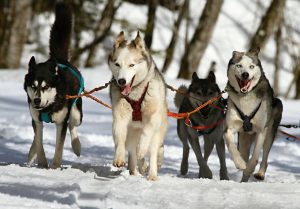

For centuries, man and dog have been the best of friends. People give dogs shelter and food while dogs help in everyday tasks.
Eventually this utilitarian relationship turned into a bond built from love and companionship. Dogs are one of the most popular pets to have, but their popularity is built upon that early cooperation.
One of those early tasks was dog sledding. Today, we go through a brief history of dog sledding and discuss some breeds of dogs that excel at this job.
A Brief History of Dog Sledding
The earliest records of dog sledding we have date it back to about 1,000 AD. The Inuit people of North America were known to use dogs for transportation. In the extreme cold of this area, there were very few modes of transport that were safe. Even today, the Canadian arctic is very dangerous, but dogs are used to help make it a little safer.
Sled dogs were commonly used to transport:
- Food
- Firewood
- Mining equipment
- Information
Sled dogs were important for the people of the north, as without them many things couldn’t get done.
While the native peoples of the Canadian North are credited as having first done dog sledding, it wasn’t until about the 1700s that Russians improved upon already existing systems.
The Inuit would have their dogs running alongside each other. There was no “pack leader” as they were all kept at the same distance from the sled. Running this way also limited the number of dogs a sled could have.
The Russians started running dogs in a straight line, or sometimes in pairs. They were also responsible for creating a pack leader. The pack leader would help keep the other dogs in line both while mushing and in social interactions.
It was later that the Alaskan Gold Rush brought more people north to pursue riches. Dog sledding was the only reliable means of transport at the time, and there was a huge demand for dogs.
Dog Sledding in Modern Times
Due to modern day technology, dog sledding is rarely used. Sledding just wasn’t needed after the invention of the airplane and later the snowmobile.
While dog sledding is still used in very rural northern communities, it is used more for recreation today. Dog sleds are often available for tourists in parts of Alaska, Canada, and Russia.
The Iditarod is also a famous dog sledding race that stretches almost 1,000 miles from Anchorage, Alaska to Nome. Not to me outdone, Norwegian dog sledders also started their own race called the Finnmarkslopet, which stretches 620 miles.
Common Dog Sledding Dogs
As dog sledding is a regional activity, there are some dogs that are best suited to the climate and demands. These dogs have been great for dog sledding from its inception to today:
- Alaskan Husky
- Alaskan Malamute
- Siberian Husky
- Canadian Eskimo Dog
- Chinook
- Greenland Dog
- Samoyed
Looking at any of these breeds, it’s easy to see a trend. Because these dogs were bred for the same purpose, they share many similarities.
First is their size. Sledding dogs needed to be larger to have the strength to pull sleds. But sled dogs couldn’t be large enough to be unwieldy. Most of these breeds sit at 35-70 lbs. They’re the perfect combination of smaller size while still having the strength and endurance to transport goods multiple miles at a time.
These breeds also have webbed paws. Having webbed paws is a must for sled dogs. This allows their paws to act like snow shoes. Instead of trekking through inches of snow, webbed paws allow these dogs to run on top of snow. It also gives them better traction so they can get moving fast.
Another similarity they all share is a thick coat. Obviously, this is necessary in harsh climate of northern Canada. Wind chills of the Iditarod have been known to push as low as -100 degrees Fahrenheit with whiteout conditions. At times this, a dog needs not only a tough outer coat, but many also have a double coat for increased warmth.
Drafting Dogs
While sledding dogs have been used in the arctic regions of the world, another group of dogs have been bred for places that are not as cold. Drafting maintains the same simple concept, having a dog pull a cart or wagon, but differs in that it does not require snow. Though, it should be noted that drafting has and still is in use in colder climates. Even today, there are groups and events you can visit to see drafting dogs do their work.
Dog sledding may be less popular, but its influence can still be felt today. In fact, the lasting relationships between humans and dogs would have never come about without sledding.










